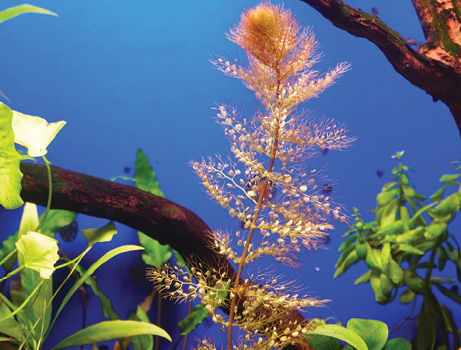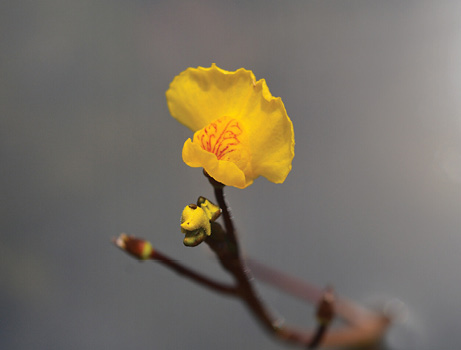Bladderwort | Utricularia spp.
Submersed | Native



Bladderworts (Utricularia) are a large, varied group of aquatic plants characterized by many small bladders formed from leaf segments. The bladders are traps to capture small invertebrates, which are digested and their nutrients used by the plant, making this plant carnivorous.
They are rootless plants with alternate, finely dissected leaves. In some species, the leaves may be whorled.
Although roots are absent, some species have modified stems that anchor to the bottom of the water body. Flowers extend above the water surface on tall stalks and are usually purple or yellow but can be white or blue.
Bladderworts are common in some areas of Mississippi but usually do not cause problems except in stagnant water conditions. They occur mainly in acidic water with a silty or sandy bottom.
Management Value
Bladderwort is a native plant that provides food and habitat for invertebrates and habitat for fish. In small quantities, it is part of a healthy pond ecosystem, although it grows quickly, which may require some control. In small areas, like around beaches or boat docks, it can be physically removed by raking.
Recommended Controls
Option 1: Diquat (3.73-pound formulation). Diquat should be applied as a submersed injection (subsurface application using a wand or hose) at 0.5 gallon per acre-foot of water. Determine pond volume prior to application. Do not exceed annual herbicide rate limits as stated on the product label.
Option 2: Fluridone (4.0-pound formulation). Fluridone should be applied as a submersed injection (3.8 ounces per acre-foot of water); reapply at the same rate 30 days after initial treatment. Determine pond volume prior to application. Do not exceed annual herbicide rate limits as stated on the product label.
NOTE: Acre-foot = average depth of pond multiplied by the pond acreage; average depth is calculated by taking the depth at 20 points across a water body and averaging the values.
Do not apply fluridone to water bodies with high flow rates; the herbicide will be flushed from treatment sites before it can control plants. Stock three to five triploid grass carp per acre to prevent re-infestation. Stock 8- to 10-inch triploid grass carp in ponds that have established largemouth bass populations to avoid predation by bass.
Read and follow all chemical label instructions, especially the section on the use of personal protection equipment.

The information given here is for educational purposes only. References to commercial products, trade names, or suppliers are made with the understanding that no endorsement is implied and that no discrimination against other products or suppliers is intended.
Publication 3735-4 (POD-11-23)
By Wes Neal, PhD, Extension/Research Professor, Wildlife, Fisheries, and Aquaculture; Dennis Riecke, Fisheries Coordinator, Mississippi Department of Wildlife, Fisheries, and Parks; and Gray Turnage, PhD, Assistant Research/Extension Professor, GeoSystems Research Institute.
The Mississippi State University Extension Service is working to ensure all web content is accessible to all users. If you need assistance accessing any of our content, please email the webteam or call 662-325-2262.



